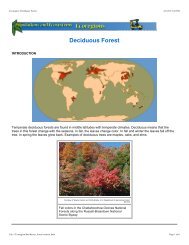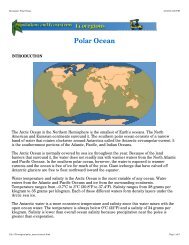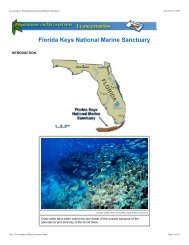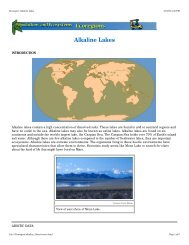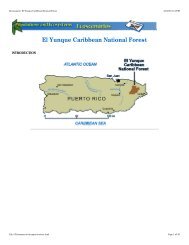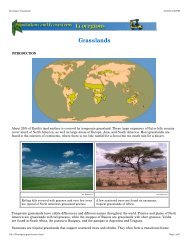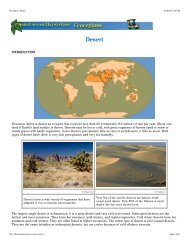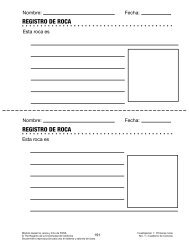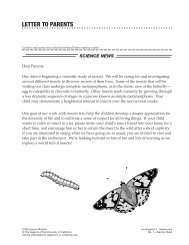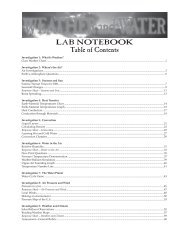Ecoscenarios Combined - FOSSweb
Ecoscenarios Combined - FOSSweb
Ecoscenarios Combined - FOSSweb
You also want an ePaper? Increase the reach of your titles
YUMPU automatically turns print PDFs into web optimized ePapers that Google loves.
Ecoscenario: Monongahela National Forest<br />
4/16/03 3:20 PM<br />
The ground layer contains a mixture of lichens, clubmosses, and moss. These organisms, along with the roots of the<br />
taller plants, help keep the soil in place. Moss covers the ground in damp shady places, and may grow at the base of tree<br />
trunks or on decaying stumps. Mushrooms, earthworms, and bacteria are also important in this layer, as they break down<br />
detritus and return nutrients to the soil.<br />
Annual productivity, or the amount of energy provided by the producers in this ecosystem, is high, about 4650 kilocalories/<br />
square meter/year of plant material.<br />
Except for 52 hectares (130 acres) the deciduous forest of Monongahela today is a secondary forest. Secondary forests<br />
are seldom as diverse as the primary, or original old-growth, forest. The trees tend to be smaller, both because older trees<br />
have been removed and because growth is stunted. More than a century ago, in Monongahela National Forest, the<br />
primary trees were spruce and white pine with interspersed hardwood, or deciduous, trees. There were some very large<br />
trees. Hemlocks, white oaks, and poplars had diameters of almost 2 meters (6.5 feet). The understory was predominantly<br />
laurels. A remnant of this virgin forest, the Gaudineer Knob Scenic Area, was spared from logging.<br />
ISSUES<br />
The mission of the U.S. Forest Service is to manage the resources of forest and grasslands for the public. It was originally<br />
established in 1905 to provide quality water and timber to the country. Congress directed the Forest Service to manage<br />
the renewable resources as well as public recreational use.<br />
Its mission also includes active research in the fields of forestry, rangeland management, and forest resource utilization.<br />
At issue in Monongahela National Forest is how logging activities should be conducted within the forest boundaries.<br />
How are natural and logged forests different?<br />
Before logging, forests experienced gaps and thinning only when trees fell naturally due to age, disease, or animal action<br />
like beaver gnawing. A forest had tipped-up roots, dead snags, and downed trees. These created habitat for birds and<br />
other animals.<br />
Forestry techniques vary, from the cutting of single trees, to cutting small plots at different times, to clear cutting large<br />
areas. Anything except cutting of single trees leads to areas where all the trees are the same age and height, and the<br />
understory is very simple. Trees are harvested for commercial purposes before they die a natural death.<br />
file:///Ecoscenario/mononga/content.html<br />
Page 7 of 11



